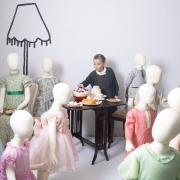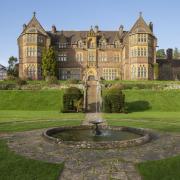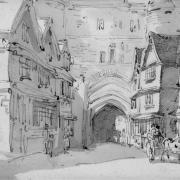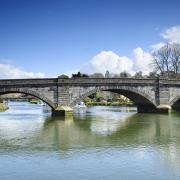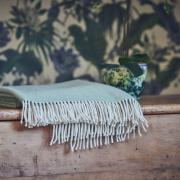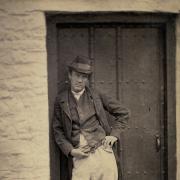Not many of us have a pile of cannon balls sitting in the fireplace, but then we don’t live in Tiverton Castle. Owner Alison Gordon takes Chrissy Harris on a tour of her home, which goes back to the first Norman earls of Devon.
Spotting a beheading axe hanging on a wall would be reasonable grounds to leave one’s host. But I’m more than happy to stay chatting to Alison Gordon.
Her knowledge and passion for her rather special home is captivating. She has lived in Tiverton Castle since 1994 after her husband Angus inherited the historic building from his uncle in 1985.
The castle was built in 1106 by Richard de Redvers on the orders of Henry I. The de Redvers became the first Norman Earls of Devon and were succeeded by the Courtenays, one of whom married Princess Katherine Plantagenet, favourite aunt of Henry VIII.

Alison is taking me through the history of her home, which includes tales of love, marriage, execution, civil war, bitter family feuds and besiegement - and we’re only just getting started.
‘It’s fabulous, such a super house,’ she says, pausing to take a well-earned rest on a handy chair (there are, luckily, a few of those dotted around). ‘Everyone always says, oh, why don’t you downsize, why don’t you stop working. But we do it because we love it here. Why should we stop?’
Being guardians of a castle is no fairytale, however. It’s a full-time occupation involving endless maintenance work, bills and dealing with litter in the doorway.
‘Oh, let me just get that,’ says Alison, reaching over to pick up a discarded takeaway coffee cup, abandoned on a ledge at the castle’s entrance. The building is open to the public between Easter Sunday to the end of October on Sundays, Thursdays and bank holiday Mondays, plus there are regular visits from local schoolchildren and special interest groups. There are also three apartments and two houses on site, available as self-catering holiday lets.


Alison and Angus work incredibly hard to provide a warm welcome to everyone who walks through their gates (it turns out the beheading axe is just for show).
‘I do enjoy showing people round,’ says Alison, who has done her research over the years. ‘I love going round historic houses because you learn so much about how to do things,’ she adds. ‘For instance, you should always choose one man or woman to be the last person in. If I start talking and then five people turn up, then they haven’t heard anything. When I see that last tall man coming into the room, I know it’s time to start.
‘And you’ve got to learn how to present things and how to amuse people. Some tours are dire.’
We agree that the more bloodthirsty things are, the better and there’s no shortage of that here.


During the English Civil War, the castle was besieged by Sir Thomas Fairfax in 1645 and was captured when a lucky shot hit the drawbridge chain. He demanded that the castle should surrender but was told that the men inside would fight to the last.
‘Usually when this happens and a town or castle is later captured, every man, woman and child are killed,’ says Alison. ‘But Fairfax was feeling merciful and they were only stripped and plundered but their lives were spared. Oh, do let’s sit down.’
Good idea. We have a quick rest before it’s time to talk codpieces.
We’re now stood beneath perhaps one of the most fascinating of the dozens of family portraits hanging in the castle.

The copy painting is of Edward Courtenay, the last Earl of Devon. He lived at the castle following years in prison in the Tower of London from the age of 12 after his father, Henry, the first Marquis of Exeter was implicated in a plot against King Henry VIII. I’m just about keeping up when Alison, who bought the artwork at an antiques fair at Powderham Castle in 2013, points out a framed image she has of the original portrait.
‘Can you spot the difference?’ she asks. ‘Look, it’s the codpiece, can you see?’
It seems the rather prudish Victorians ‘photoshopped’ their copy and made the codpiece far less, er, prominent.
‘Poor boy…,’ says Alison, unlocking the next door as we make our way back out into the courtyard. The gardeners are hard at work, busy taking care of the level, three-acre grounds here, which include a spring bulb border, rare shrubs, kitchen garden and orchard. It looks glorious today. We take our time strolling around, while Alison talks me through what was where in terms of the ancient remains of the original stone building and what’s thought to be the entrance to one of the secret underground passages. Kids must love it here.

‘They do like coming to visit,’ says Alison, who always makes a point of showing them the gloomy depths of the ‘medieval loo’, still visible in the thick stone exterior wall. ‘I explain to them that children as young as nine were sent down to clean them,’ adds Alison. ‘They can’t believe it.’
Alison clearly enjoys sharing her home and its history with visitors of all ages, but she also likes to be behind the scenes. She and Angus live in the ‘modern’ 17th century section of the building – a welcome retreat.
‘It’s the most comfortable bit,’ says Alison, as we head inside. The couple spend most of their time in their high-ceilinged but cosy sitting room, surrounded by piles of books and magazines.
‘I’m always buying books,’ says Alison. ‘I haven’t got time to read but I still buy them.’
Down the hall we pass the kitchen and go into the dining room and then through to beautiful library. It’s like a period drama set.


‘This room came into its own for parties at one time,’ says Alison, who is well connected to her local community. ‘We used to do a lot of entertaining but not so much anymore.’
The couple spend a great deal of time working away in their office. There’s still such a lot to do here. The holiday lets are open all year round and then there are tours to organise. During my tour, Alison spots a couple of roof tiles that need replacing and then she reminds herself to call the carpet fitters.
‘It’s one thing after another, it’s constant,’ says Alison. Doesn’t she ever fancy giving it all up and moving to a nice, modern box?
‘No,’ she says, immediately. ‘I enjoy everything about being here. It’s a wonderful house.’
Go and see it for yourself.
tivertoncastle.com






